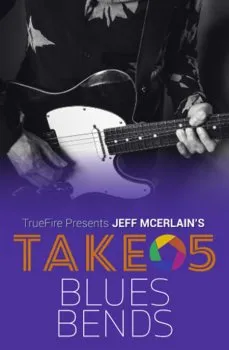P2P | 09 October 2018 | 688 MBGuitar is one of the only instruments that you can actually perform a bend on and the technique is inherent in all styles of blues and rock guitar playing, Bends allow players to develop their own voice while adding a vocal quality to their playing.
It’s one of the most expressive techniques on the guitar and is certainly an essential skill that every blues guitarist needs to perfect.
This Blues Bends edition of Take 5 from Jeff McErlain is an accelerated curriculum designed to help get your bending technique up to snuff quickly without having to struggle through a lot of tedious exercises.
You’ll start the course with a quick primer during which Jeff will introduce you to best approaches for executing whole-step bends, minor third bends, half-step bends, pre-bends, double stop bends, and a few vibrato techniques, which are commonly used with bends.
Jeff will then guide you through 5 blues bending performance studies, progressing from basic to more advanced applications of the technique.
Level 1: Blues Bends”Let's check out a slow blues in A using two specific whole step bends found in the Am pentatonic scale: the D to E, which is the 4th to the 5th, and G to A, which is the b7 to the root. These two notes are a great way to get into bending and outlining the changes on an A blues as well. An A minor pentatonic scale is spelled A-C-D-E-G, as you can see the scale is made up of whole steps and minor thirds. The two whole step bends we'll be working on are the most common bends in the pentatonic scale.”Level 2: Blues Bends"In this study, we'll take a look at the two minor 3rd bends in the pentatonic scale. One is the minor 3rd between the root and b3rd, and the other is between the 5th and b7th. These bends are exceptionally cool, and we hear guys like Clapton, Page, and Gilmour use them all the time. One of the real kings of the bend is the legendary Albert King. I'm also tweaking the b3rd a little, and this is easily the MOST IMPORTANT bend to master because it ain't the blues without it!”Level 3: Blues Bends”One of my favorite bends is the half-step bend. We've been mostly dealing with the minor pentatonic scale up until now, which is made up of whole steps and minor 3rds. In this example, we're going to dig into a full minor scale and use the half-steps the scale now gives us. A minor pentatonic scale is a minor scale without the half-steps, just as a major pentatonic scale is a major scale without the half-steps. Ever wonder why a pentatonic scale is so much easier to use than a full 7 note scale? It's more than just the fingerings — the half-steps are the notes that can actually cause more tension and clash for better or worse. The half-steps require more attention, but they can also really add another dimension of expression.”Level 4: Blues Bends”In this study, we're going to check out a take on Free's " Walk in My Shadow". It a G blues and we're going to build on the bends and vibrato we were introduced to in the previous sections. The big vibrato I use here is new and very cool and also a rock essential. It adds a huge amount of excitement to a solo. It, like everything, should be used appropriately. If you always go for really big wide vibrato it can get very tedious, and frankly, I think it can sound silly. When used at the right time, however, it sounds awesome!”Level 5: Blues Bends”OK hold on to your hats, because we all wear them, right? This is the last exercise where I put all the techniques together. Of course, this is just the start of what can be done, and that to me is one of the best parts of playing guitar: We are never done and constantly refining what we know. The beauty is truly in the details, a bend is just a bend. Once you get it in tune, that's just the start of a whole new world of musical opportunities and avenues. String bending helps emulate the qualities of the human voice more than an instrument like a piano can. I'd say traditional jazz guitarist don't usually bend strings that often, as those jazz boxes usually have very heavy strings on them, but everyone else usually does.”Jeff will explain and demonstrate all of the key concepts and approaches along the way.
You’ll get standard notation and tabs for all of the Performance Studies.
Plus, Jeff includes all of the rhythm tracks for you to work with on your own.
In addition, you’ll be able to loop or slow down any of the videos so that you can work with the lessons at your own pace.
Grab your guitar and let’s Take 5 with Jeff McErlain!

发布日期: 2018-10-10